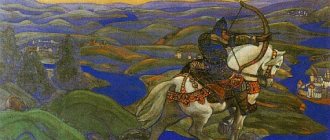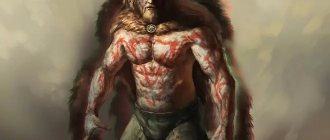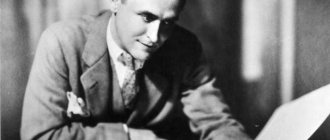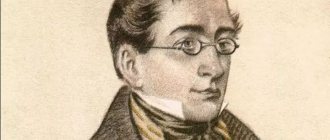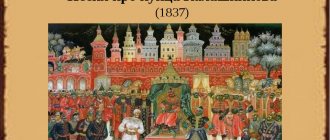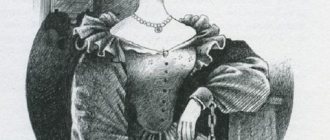The epic “Ilya Muromets and Nightingale the Robber,” the analysis of which is the subject of this review, tells about the times of Kievan Rus. The series of works about this hero was very popular among the Russian people, and is currently included in the school literature curriculum. These works of oral folk art reflect the historical realities of Ancient Rus', and therefore are interesting not only from an artistic, but also from a literary point of view.
Description of the forest
The epic “Ilya Muromets and the Nightingale the Robber” is distinguished by its concise but detailed description of events. An analysis of an ancient song should include a detailed analysis of nature, which will allow schoolchildren to better understand the environment in which the main event of the work took place. The unknown author uses colorful sayings, telling that no one walks or rides a horse along the path near the city, and even animals and birds do not live here. These epithets, listed in song form, perfectly convey the gloomy atmosphere of the dense forest that the hero passes through. What follows is one of the important points in the work: this is a description of the hero’s battle with the enemy.
Plot - summary:
- On the way to Kyiv, Ilya Muromets defeated his enemies near Chernigov. For this, the residents called him to be a governor.
- Ilya refused, people told him that the Nightingale the Robber lived on the direct road to Kyiv.
- Ilya went the straight road and caught the Nightingale, tied him to the saddle and rode with him.
- On the way, the robber’s relatives wanted to recapture him, but Nightingale told them not to touch Ilya of Muromets, but to offer him food and money, but Ilya did not pay attention to them.
- Ilya reached Kyiv and met Prince Vladimir. The prince did not believe that he was able to come by the direct route.
- Ilya Muromets showed the prince the captured Nightingale the Robber, who whistled throughout Kyiv. Then Ilya went with him to the field and cut off the robber’s head.
The image of a hero in battle
The epic “Ilya Muromets and Nightingale the Robber”, the analysis of which, following the composition of the song, must be divided into several semantic parts, focuses on the military exploits of the hero. In the lines dedicated to the battle, the author repeats the word “strength” several times, using it in different ways, wanting to convey in the most expressive form the power of the enemy army that the hero defeated. In an effort to emphasize the character's feat, he talks in detail about how the warrior destroyed the enemy, beating him, trampling him with a horse and stabbing him with a spear.
Main characters
Ilya Muromets
The hero of the Russian land, strong and fearless. Determined, wise knight. Never deviates from the intended path, always moves straight, without avoiding obstacles and dangers. He is the defender of the Russian land, sacredly protecting his people from the invasion of enemies. Fair and honest, he does not pursue power and wealth, remaining a simple warrior, ready to protect and defend his land.
Nightingale - the robber
The fairy-tale hero, personifying all evil forces, is an enemy and destroyer. The robber's main weapon is his mighty whistle, which causes everyone to fall dead. Fearless, strong conqueror, confident and proud. He killed many people passing by his nest. He could not cope with Ilya Muromets, who cut off his head.
Revealing the character in a conversation with residents
The analysis of the epic “Ilya Muromets and the Nightingale the Robber” must be continued with a thorough analysis of the hero’s behavior during a conversation with the people of Chernigov, who, for his feat of arms, asked him to become their governor. Here it is necessary to note the historical realities reflected in the song: the title of governor at the time in question was military, his functions included the responsibility of defending and defending the city from enemy attacks, sieges, leading troops into battle or organizing the people's militia. Therefore, such a request from the residents means recognition of his military merits and military valor. Analysis of the epic “Ilya Muromets and Nightingale the Robber” should include revealing the character of the hero through his speech and language. He speaks in simple folk language, his words contain song epithets familiar to the reader, which brings him closer to ordinary peasants from the city of Chernigov. The second important point in this scene is the straightforwardness and modesty of the hero. The warrior does not talk about his exploits, about the danger that awaits him on the way to Kyiv, he is only interested in the path to the capital itself, and he asks his interlocutors to explain the way to him.
Main characters
Ilya Muromets
Ilya Muromets comes from the village of Karacharova, near Murom. The son of a peasant. Ilya's father's name was Ivan Timofeevich. Father loved and pitied Ilya very much. Until he was thirty, Ilya sat idle, and after thirty he suddenly rose to his feet and felt great strength within himself.
Ilya is a deeply religious person. Having risen to his feet, he feels the need to prayerfully thank God for the strength given to him. It is for this purpose that, with the blessing of his parents, he goes to Kyiv, a city famous for its abundance of churches. Another goal is to see the Kyiv prince Vladimir.
On the way to Kyiv, he performs his first exploits: he disperses the robbers who attacked him in the deep forest, then beats the Basurman troops stationed near Chernigov, and finally defeats the Nightingale the Robber, entrenched in the Bryansk forests on the Smorodinka River.
Ilya Muromets accomplishes what no one has managed before; he defeats those whom everyone feared. He is strong with great strength, powerful, infinitely brave, at the same time kind and generous, knows how to forgive his enemies.
Nightingale the Robber
I sat on the road leading from Chernigov to Kyiv for thirty years. He did not let anyone through: he killed everyone who walked along this road with his loud whistle. This continued until Nightingale waited for Ilya. Only Ilya was able to withstand his whistle and re-whistle it.
The Nightingale the Robber almost killed Alyosha Popovich and Dobrynya Nikitich with his whistle. For this, the Nightingale the Robber was killed by Ilya Muromets.
First mention of a negative character
The description of the epic “Ilya Muromets and the Nightingale the Robber” allows us to understand the features of Russian folk art. It reflected the historical thinking of ancient Russian society, in particular, how people of that time imagined the enemies of their native land. Therefore, despite the fabulous and fantastic appearance and behavior of the villain, in him, undoubtedly, one can discern a collective image of the enemies with whom the ancient Russian princes and their brave retinue fought across the borders of the young state. From the story of the residents of Chernigov, the reader for the first time gets an idea of what the future main opponent of the hero looks like. The characterization of the epic “Ilya Muromets and the Nightingale the Robber” will help schoolchildren understand the peculiarities of the Russian people’s vision of the enemy: he whistles like a bird and growls like an animal, lives in an oak tree, and from his screams all nature literally trembles, and the passer-by dies.
Minor characters
Eldest daughter of the Nightingale the Robber
More than other daughters (and the Nightingale the Robber has three in total) he loves his father. She cries when she sees Ilya carrying his father tied to a horse. She tries to kill Ilya Muromets with an iron gateway at the moment when he tries to enter his father’s house, and accepts death from his spear.
Sons-in-law of the Nightingale the Robber
Well done, endowed with heroic strength, but not as strong as Ilya Muromets. Cunning, insidious. They are trying to lure Muromets into Nightingale’s house by deception, so that they can kill him later.
Kyiv Prince Vladimir
All Russian heroes come to Prince Vladimir. Ilya Muromets is also coming to see him. Prince Vladimir initially shows curiosity and mistrust towards Ilya. He does not immediately believe in the strength of Ilya Muromets, and puts him to the test. But, making sure that Muromets has dealt with the Nightingale the Robber, he brings Muromets closer to himself.
Alyosha Popovich and Dobrynya Nikitich
Bogatyrs. They believe that Ilya Muromets possesses heroic strength only after he introduces them to the Nightingale the Robber and asks him to whistle. From the Nightingale's whistle they fall to the ground.
Characteristics of a hero in battle
The central place in the work is occupied by the battle scene between the hero and the villain. In this case, students should pay attention to the behavior of the two wrestlers. An unknown author describes the leisurely actions of the hero, who slowly took a bow, put an arrow in it, took careful aim and knocked out the enemy’s eye. Thanks to this calm, measured narration, the epic “Ilya Muromets and the Nightingale the Robber” sounds very epic. The characteristics of the heroes are fully revealed in this confrontation. And if the main character behaves calmly, confidently, firmly, then his opponent, on the contrary, acts resourcefully, like an animal. It is not for nothing that he is endowed with animal traits: he whistles like a bird, screams like a wolf. Such a contrast focuses students’ attention on the bravery of the hero and the rapacity of the robber.
Incident in the field
Next, the epic tells how the villain’s relatives wanted to free him. It turned out that Nightingale had daughters who ordered their husbands and sons-in-law to chase the knight into the field. The author focuses on the huge number of enemy gatherings. Here it is necessary to point out to the schoolchildren the fact that they were not even able to try to take away his booty from the hero. Thus, the epic seems to emphasize that it is useless to fight him, and if he has already won, then no enemy force will be able to get the better of him.
Proverbs for the work:
Not the hero who expects a reward, but the hero who goes for the people.
The hero is not famous by birth, but by his feat.
Stand boldly for what is right.
Other readers' diaries here
Hello! My name is Maria, I am the author of the Pushkin website. I hope that my site helps you, in turn I ask for your help. My son was diagnosed with autism. He needs daily correctional activities, if you can help, I will be grateful to you. Every 10 rubles you give is another chance for my child to live a full life. Collection page here
In the city of Kyiv
The next important point in the work is the description of the capital, where the hero arrived along with his terrible but defeated captive. This scene reflected the historical realities of life at that time. The reader is confronted with pictures of urban life, princely chambers, mansions, a courtyard, a retinue, and a brave squad. One of the main places in this scene is occupied by Prince Vladimir the Red Sun, a beloved hero of folk tales. It is to him that the hero comes to the palace and talks about his feat. The listeners are amazed at what was said, and then Ilya Muromets leads them into the courtyard where his bound opponent is located. He orders him to demonstrate his strength, and then the villain, in the presence of the prince and his squad, again whistles and screams like an animal. Then the chief cuts off his head. A comparative analysis of the epic “Ilya Muromets and the Nightingale the Robber” with other works about this hero shows that this beloved folk character was described in different ways in songs. He is sometimes called an old glorious Cossack, sometimes a brave warrior, or a simple villager. However, the main feature of this hero - indestructible strength and readiness to selflessly defend the Russian land from enemies - runs like a red thread through the cycle of legends about him.
The heroes of the epic Ilya Muromets and Nightingale the Robber - who are they?
Every Russian, Ukrainian, and Belarusian has known since childhood about such a fairy-tale hero as Ilya Muromets, who became
literally the personification of Slavic strength, heroism and devotion to duty. The very word “hero” is involuntarily associated, first of all, with Ilya Muromets, described as an unusually powerful, stern and valiant warrior. The last generations of residents of the countries that arose on the site of Ancient Rus', that is, Russia, Belarus and Ukraine, know about this character mainly only from literary processed children's books and textbooks, and where, in fact, he comes from is mostly known only to specialists. Ilya Muromets is the hero of epics - epic songs related to the Scandinavian sagas, describing the exploits of ancient Russian warriors of the 11th - 13th centuries, i.e., the pre-Mongol period. Epics were composed
not so much in order to preserve the names and exploits of heroes in the memory of the people, but to occupy people’s leisure time at feasts, at ceremonial meetings, etc. They were listened to in the same way as today we watch feature films about wars, especially without going into the authenticity of the events shown. Therefore, the chronology of events in them is not verified; events from completely different years are intertwined with each other; much is taken from folk legends that have been retold and altered a hundred times. So, one of the epics says that Ilya Muromets was familiar with another hero - Alyosha Popovich, another epic tells that Alyosha Popovich died in a battle with the Mongols on the Kalka River, that is, in 1223. However, another epic tells about Ilya Muromets and Tugarin (Tugorkan), while the Kipchak Khan Tugorkan died in 1096. It turns out, if you believe the epics, Alyosha Popovich lived for about a century and a half, and remained combat-ready! The writers of epics, of course, did not study either documents or chronicles; they simply recalled the legends known to them, often confusing one with the other. But this, of course, does not mean that the epics were not based on real events, and the task of historians is to use epics, chronicles, and legends to restore, as far as possible, the picture of real events.
The biography of Ilya Muromets in epics is described in sufficient detail. It is reported that until the age of 33, he was bedridden, unable to move his arms or legs. One day, the Magi approached his house - people often mentioned in epics and chronicles, who possessed some kind of magical abilities, in all likelihood, ministers of Slavic pagan cults. The Magi asked him to bring them water, to which Ilya replied: “I have neither arms nor legs, I’ve been sitting on a seat for thirty years.” However, the wise men insisted, and then he suddenly stood up and brought water. At the request of the Magi, he himself drank the water brought and immediately recovered. Then he drank again and gained extraordinary physical strength, which is why he involuntarily began to shake and destroy everything around him. Then he drank the water for the third time, and his strength decreased by half, but still remained incredibly powerful. The Magi told him that he must go to Kyiv to enter the service of Prince Vladimir. Prince Vladimir is also a character often mentioned in epics, but which particular Vladimir we are talking about is never specified. In the past, the epic Vladimir was often associated with Vladimir Svyatoslavich Krasno Solnyshko, the fourth supreme prince of united Rus', who streamlined its administration and introduced the Christian religion as the state religion. However, a more thorough analysis of all the information contained in the epics and a comparison of facts allows us to conclude that we are talking rather about Vladimir Monomakh, who reigned in Kyiv from 1113 to 1125. Various epics about the meetings of Ilya Muromets with Prince Vladimir
reported several times. Thus, apparently, Ilya Muromets lived in the first half of the 12th century, during the era of the struggle of Rus' with the Kipchaks-Polovtsians. This leads to the conclusion that his real prototype was the famous strongman Ilya Pechersky, who was born in the city of Murom, who, according to his life (church biography), once suffered a serious illness, and after a miraculous healing was baptized. He is known as a monk of the Kiev Pechersk Lavra, and in 1988, an examination of his relics established that he suffered paralysis of the limbs as a child. According to the epic, Ilya said goodbye to his parents and, going to Kyiv, initially visited, at the direction of the Magi, a huge stone, which he moved from its place and discovered weapons, armor and a horse there. With all this he came to serve the prince. The legend about the discovery of heroic weapons hidden under a stone or stuck into it, or located in a dangerous place, is widespread among different peoples (for example, King Arthur's Excalibur). Apparently, the storytellers included this episode in the epic to enhance the heroic image of Ilya, but this story has nothing to do with the real Ilya Muromets.
The most famous feat of Ilya Muromets today is the victory over the epic villain Nightingale the Robber. A separate epic tells about this, beginning with the following words:
Further, as reported, Ilya discovers that Chernigov is besieged by a large enemy army, enters into battle and destroys it. For this, the Chernigov residents warmly welcome him and offer to be their governor in the city, but Ilya declares that he did not come for this and asks to show him the direct road to Kyiv. The Chernigov residents answered him that the direct road had fallen into disrepair and was overgrown, because no one dared to drive or walk along it:
It is further noted that the roundabout route to Kyiv is twice as long (a thousand miles instead of five hundred in a straight line), and Ilya heads along the direct road. Because of the whistle of the Nightingale the Robber, his horse cannot continue to move forward, but the hero himself resisted and wounded the enemy in the eye with an arrow. Having removed the Nightingale the Robber from the oak tree, Ilya Muromets tied him to a horse and took him to Kiev, driving past his “nest”, in which his three daughters were sitting and watching through a lopsided window, not being able to immediately understand whether it was the Nightingale carrying Ilya , or Ilya Solovya. Finally, it dawns on them that their father has been captured, and they call their husbands for help. The sons-in-law of Nightingale the Robber grab the spears and run to kill Ilya Muromets and free his father-in-law, but Nightingale persuades them not to enter into a fight with the hero, but to come to an amicable agreement with him, inviting him into the house and welcoming him with food and drink. Ilya, however, does not give in to persuasion and takes Nightingale further to Kyiv. In Kyiv, Prince Vladimir wants to personally see the destructive effect of the Nightingale the Robber’s whistle and orders him to whistle. However, Nightingale arrogantly refuses, saying that he will fulfill the demand only of the one who managed to capture him. Then Ilya Muromets orders him. However, the Nightingale first demands a cup of wine, saying that due to the wounds received in the battle with him, he cannot whistle otherwise. Having drunk the wine, he emits his terrifying whistle:
After this, Ilya Muromets takes him to the field and cuts off his head with the words:
Of course, there are real events behind the song legend. Moreover, the signs of the place where Ilya Muromets captured the Nightingale the Robber are given in such detail in different versions of the epic,
that it was not difficult for researchers to find him. The epics indicate the city of Murom, the village of Karachirovo (or Karacharovo), Chernigov, Brynskie (Bryansk) forests, the Smorodina river, distant oaks. All this refers to the village of Nine Oaks, Khotynetsky district, Oryol region of Russia, located in
one kilometer from the border with the Bryansk region, where the ancient city of Karachev is located, not far from which the Smorodinovka River flows. The route from Murom to Kyiv, indeed, ran through the Bryansk region and Chernigov. However, the fact that Ilya set off to fight the robber from Chernigov is most likely an epic mistake: Chernigov was already behind the Bryansk forests, and it was not so far from Kyiv. Probably, two independent legends merged here: one is about Ilya’s victory over Nightingale, the other is about his salvation of Chernigov. The writer of the epic has already freely linked these two events into one story, without worrying about geographical accuracy.
Who is Nightingale the Robber? Sometimes he is depicted as a demonic creature - half-man, half-bird, based on his name and ability to whistle like a nightingale. However, this is already a late hoax of the legend. In epics, the appearance of the Nightingale the Robber is, in general, almost not described, but one can understand that he can sit astride a horse, that he has a large family, whose members live in a “nest”, but which has some kind of rickety window, and wields spears , eat ordinary human food, while the Nightingale himself talks to Prince Vladimir and drinks wine. According to the epics, it turns out that the Nightingale the Robber is fully human, and his “bird” name is rather a nickname for his ability to whistle, and he lives with his family in an ordinary human house, which is simply called a nest by analogy with his nickname. In the images of the era of the Moscow State, and from there - in the paintings of artists of the New Time, the Nightingale the Robber appears in the guise of a steppe nomad: with characteristic Mongoloid facial features, dressed in a Turkic costume. But this is most likely a reference to the centuries-old confrontation between Rus' and the Steppe: with the Khazars and Pechenegs, the Polovtsians, then the Mongol-Tatars. That is, the artists associated any enemies of Rus' primarily with the steppe inhabitants, so they gave the epic Nightingale the Robber the appropriate appearance. Although Nightingale is called a robber, nowhere in the epics is it mentioned that he robbed his victims or appropriated someone’s property. In fact, he simply blocked the shortest road to Kyiv, whistling to death everyone who tried to pass along it. No one except Ilya Muromets could cope with him. The Nightingale clearly has no regard for such a powerful and formidable figure as the Kiev prince, even being captured, he demands a cup of wine for himself, and the demand is fulfilled. Thus, the Nightingale the Robber is not a bird or some criminal hiding in the forests. This is a person who has significant power and enjoys significant respect in the society of that time: only such a person could behave arrogantly with the ruler of a powerful country and make some demands while being captured by the prince.
The answer to this question comes from Russian chronicles. As it turns out, the territory of the modern Bryansk and Oryol regions of Russia during the times of Ancient Rus' was the western area of settlement of the East Slavic tribal association of the Vyatichi. “The Tale of Bygone Years” describes the Vyatichi and the Radimichi and Northerners who lived next door to them in the pre-Christian era as peoples who lived in the forest “like animals,” who cursed in front of their fathers and daughters-in-law, who ate “everything unclean,” who kidnapped brides during holidays and who had several wives. It is clear that the chronicler carried out such a rough description of the Vyatichi from the point of view of the Kievites who adopted the Christian faith and lived according to strict patriarchal traditions earlier than other East Slavic tribes. of the primitive communal system for a very long time , and even in the economy primitive elements played an important role (gathering, the use of natural shelters for housing). After the unification of the East Slavic lands around Kiev and conversion to the Christian faith, the Vyatichi, accustomed to primitive equality, who, due to the low development of the economy, experienced a strong fear of natural elements and therefore were afraid to leave the cults of the pagan gods who supposedly controlled these elements, had a very difficult time adapting to life in conditions of developed statehood and political unity of command. They saw the Kiev prince as a foreigner and a usurper, imposing his own customs on them, the free inhabitants of the forests, robbing them during tribute collections, and the imposition of the Christian religion as an encroachment on their spiritual identity. Even a century later, the princely power in the lands of the Vyatichi was poorly maintained, and Vladimir Monomakh, who, apparently, is the prince Vladimir for whom Ilya Muromets served, made several military campaigns against them. That is, Ilya Muromets, driving through the Bryansk forests, followed, in modern terms, a “hot spot” - a territory whose population was gripped by separatist aspirations and reluctance to recognize the supreme power of the Kyiv prince. It was also difficult to suppress the separatism of the Vyatichi because they often settled in a primitive manner deep in the forests, where the cavalry, which constituted the main striking force of the princely army, could not deploy in battle formation and easily maneuver among the trees. In the cultural and economic centers of the Vyatichi land, located in the river valleys, of course, official power was held and junior princes and princely governors sat, but in more remote, wooded areas, real power lay with local leaders who did not recognize the Kyiv prince as their ruler. It was not for nothing that the Nightingale the Robber sat in the forests near a birch on an oak tree, and somewhere there was his “nest”.
Thus, Nightingale the Robber was probably a Vyatichi tribal leader, as they would say now, an “authority” who refused to obey the central authority. Therefore, even in captivity, he refused to obey the Kyiv prince, citing that it was not he who defeated him, but Ilya Muromets. Apparently, he belonged to the local tribal nobility, and therefore demanded respectful treatment in captivity; he asked to bring him a cup of wine, which was done. The word “Nightingale” in those days could be a person’s personal name, could be a nickname given for the ability to whistle (as follows from the epic), chirp like a bird, sing or speak eloquently. The fact that the Christian name of Nightingale is not mentioned in the epic may mean that, having refused to obey the Kyiv authorities, he also renounced the Christian faith, considering it alien and imposed by the hated Kiev, although his patronymic mentioned in the epic - “Odikhmantyev”, recalls structure of a Christian name. Perhaps his father was a Christian, but he himself, having decided to fight Kiev, refused baptism and left himself only a traditional Slavic name. Of course, his whistle, which kills everything around him, is a hoax related to the popular mythology of the peoples of the world about creatures that kill people and animals with their voices. Similar myths existed among the Slavs, and the writer of the epic identified the whistle of the Nightingale the Robber with them. In fact, the whistle and animal cry itself, which is mentioned in the chronicle, rather mean the conventional sounds with the help of which the Vyatichi detachments hostile to Kyiv, led by Nightingale, coordinated their actions in the forests. And the extraordinary consequences of the whistle: death or falling without
feelings of people and animals, admiration for the land of forests, probably an allegory, meaning the strong influence that Nightingale had in the Vyatichi land and the fear that he instilled in fellow tribesmen who sympathized with Kyiv. That is, Nightingale the Robber was a noble leader
the Vyatichi, disobedient to Kyiv, took refuge from the princely power in the forests and smashed princely detachments in the forest wilds, and his influence was so great that supporters of Kyiv in the Vyatichi land could not feel safe. This, in general, is a common picture in all regions that for some reason are poorly controlled by the central government: in addition to its formal representatives, local authorities and underground leaders always operate there, turning in fact into a second, sometimes even more influential, government.
The epic about Ilya Muromets and the Nightingale the Robber looks like a continuation of the epic about the healing of Ilya Muromets. However, this can also be an artificial connection by the writer to give the story a more connected and romantic appearance. Of course, in reality, no matter how strong Ilya Muromets is, he would hardly dare to travel alone along such a dangerous road that everyone avoids. Undoubtedly, he was accompanied by a detachment of fighters, with the help of whom he captured the Nightingale the Robber. Quite possibly,
that this story happened not when Ilya was traveling from his native Murom to serve in Kyiv, but only later - when he was already serving Prince Vladimir. He could have been deliberately sent by the Kyiv prince at the head of a detachment of warriors to seize Nightingale, who had established his power over the land of the Vyatichi. As follows from the epic, people from the Nightingale clan tried to free their leader, but Nightingale, for some reason (perhaps fearing that this would lead to an unequal big war with Kiev for his fellow tribesmen) convinced them not to do this. As for the epic demonstration by Nightingale of the murderous power of his whistle in Kiev, this allegory may mean his ordinary interrogation as a prisoner, during which he spoke about how strong the independent spirit of the Vyatichi is still, how many more people are ready to resist Kyiv at any cost than deeply struck the prince and Kyiv dignitaries. Therefore, according to legend, the Nightingale whistled only when Ilya Muromets ordered him to do so and only after he drank a cup of wine: as a noble captive, he agreed to answer questions only after he was received in a worthy manner. But the epic, as already mentioned, was composed for the amusement of people, and not for teaching them historical facts. At the time of her appearance, all her allegories were probably quite understandable to people. But generations later, the story itself was forgotten, and the song story about two opponents - Ilya Muromets and Nightingale the Robber - turned into a myth.
20 801
